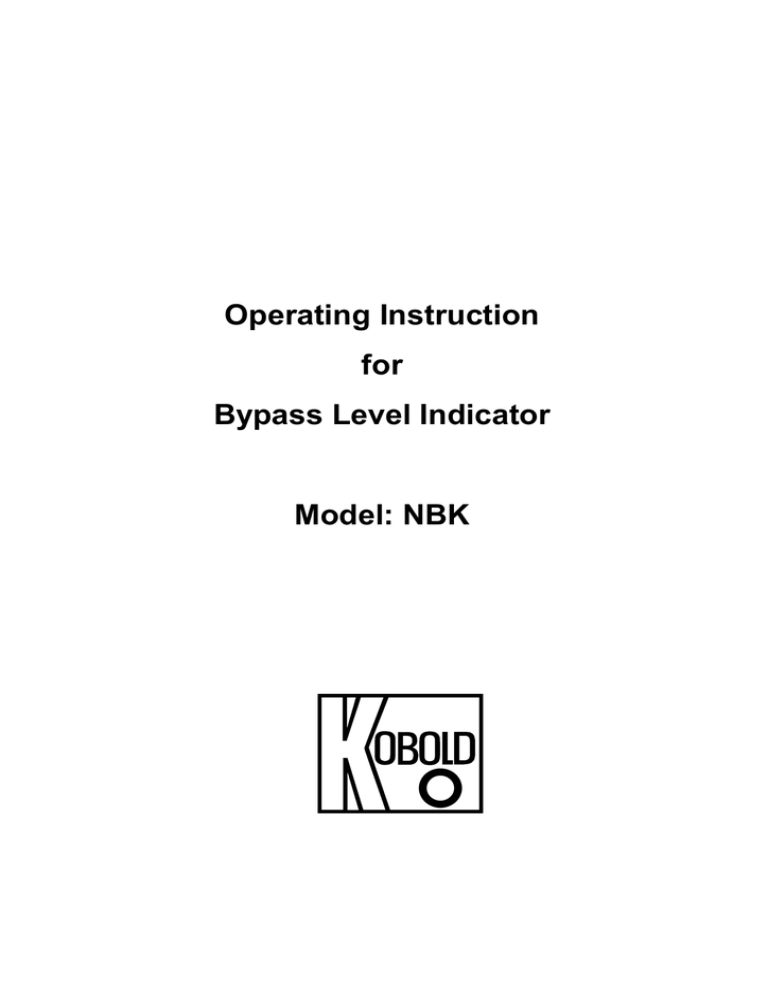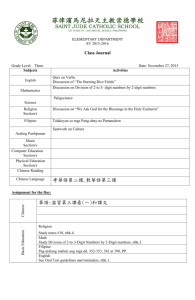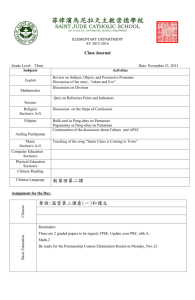Operating Instruction for Bypass Level Indicator Model: NBK
advertisement

Operating Instruction for Bypass Level Indicator Model: NBK NBK 1. Note Please read and take note of these operating instructions before unpacking and setting the unit for operation, and follow the instructions precisely as described herein. The devices are only to be used, maintained and serviced by persons familiar with these operating instructions and with the prevailing regulation applying to procedural safety and the prevention of accidents. When used in machines according to machine guideline EWG commissioning is prohibited until it is established that the machine meets the general requirements of the guideline. 2. Contents 1. 2. 3. 4. 5. 6. 7. 8. 9. 10. 11. 12. 13. Note .................................................................................... 2 Contents ............................................................................. 2 Specific Application ............................................................ 3 Operating Principles ........................................................... 4 Instrument Inspection ......................................................... 4 Mechanical connection ....................................................... 5 Electrical connection........................................................... 6 Commissioning ................................................................... 8 Trouble shooting................................................................. 9 Technical Data.................................................................. 10 Maintenance ..................................................................... 11 Dimensions....................................................................... 12 Declaration of Conformance............................................. 13 Manufactured and sold by: Kobold Messring GmbH Nordring 22-24 D-65719 Hofheim Tel.: +49(0)6192-2990 Fax: +49(0)6192-23398 E-Mail: info.de@kobold.com Internet: www.kobold.com Seite 2 NBK 05/02 NBK 3. Specific Application The NBK bypass level indicator is used for continuous measurement, indication, and monitoring of liquids in tanks, vessels, reservoirs, basins etc. Information is displayed on a magnetically coupled roller indicator. Bypass measuring tube system The bypass tube is attached at the side of the vessel with a connecting flange or a screw neck. The installation position is always vertical. The NBK should only be used for liquids with the medium density specified on the nameplate. Otherwise the indication will deviate and the float may submerge or float up too high. Vessel inner pressure and medium temperature should not exceed the specified maximum values, as this can lead to the destruction and maloperation of the bypass system. It is imperative that the materials used are adequately resistant to the liquid being measured. Proper operation is also impaired by: · High degree of soiling · Lumpiness · Crystallization · Ferrite particles Electrical limit value controllers (option) The optional electrical limit value controllers serve to signal a preset level. Important! Caution! Observe the allowed electrical ratings for the limit value controller. Maximum values Breaking capacity: Switching current: Switching voltage: Standard contact 40 VA 0.8 A 230 V Explosionprotected contact High temperature contact 20W/45 VA 0.8 A 220 V 80 VA 1A 220 V Remote sensor reed contact chain of resistors (option..M..) The optional remote electrical sensor converts the liquid level to a resistance value, which serves to teletransmit the level as an electrical quantity. Downstream control electronics transform the signal to a standard signal (e.g., 4–20 mA), or control the level. Please note max. medium and ambient temperatures. Remote sensor magnetostrictive sensor (option..T..) Remote level transmission can be achieved by mounting a magnetostrictive sensor outside the bypass tube. A continuous standard 4 to 20 mA signal is obtained with a built-in transmitter. This signal can then be displayed on analog or digital indicators. NBK 05/02 Seite 3 NBK 4. Operating Principles The NBK works according to the principle of communicating tubes with a float, that is, the level in the bypass tube corresponds to the level in the vessel. A float with flush-encased magnet in the bypass tube follows the liquid level, and transfers it, in a non-contacting manner, to a roller indicator that is externally attached. As the float passes by, the red/white rollers rotate through 180° about their own axis. Red indicates the actual level, whereas white means no level. Contact devices and/or remote sensors can also be fitted. The arrangement is not important as the annular magnetic field acts in all directions. 5. Instrument Inspection These devices are checked before dispatch and sent away in perfect condition. Should the damage to a device be visible, we recommend a thorough inspection of the delivery packing. In case of damage, please inform your parcel service/ forwarding agent immediately, since they are responsible for damages during transit. Please cross-check the instruments with the delivery note where all options are listed. Seite 4 NBK 05/02 NBK 6. Mechanical connection Standpipe Indicator Float Roller indicator Thermal screening (for 400°C-switch only) Clamp NBK 05/02 Remove bottom flange from bypass tube, and insert the cylindrical float in the NBK bypass tube with the designation "TOP" at the top. Re-position the gasket and close the bottom flange again; firmly tighten with screws. Mount and tighten the bypass tube to the vessel to be monitored with process connection and seal. Normally it is sufficient to fix the complete NBK with both process connections. However should the NBK be subjected to constant shock or strong vibrations it is recommended that the instrument is secured with rubber-damped tube clips. The bypass tube should never be welded. Mount and tighten the magnetic roller indicator - if not already mounted at the works - on the bypass tube with the two accompanying taut ribbons. Mount and tighten the dry-reed switch if available and not already mounted at the works - on the bypass tube at the opposite side of the roller indicator with the accompanying taut ribbon (ex contact: two taut ribbons). The height of the switch contacts may be selected at will. The cable connection must point downwards. Tighten the tube clips until the contact cannot be closed any further. The switch must be snug against the stand tube. The switching function of the switch is impaired by an enlarged air gap. Fasten the high temperature switch to the bypass tube with the tube clip fixed to the tube. Mount and tighten remote sensor - if available and not already mounted at the works - on the bypass tube with the taut ribbons. The remote sensor must cover both process connections fully. The cable terminal box is situated at the top. Seite 5 NBK 7. Electrical connection 7.1. Switch (option) With cable connection brown black blue Connection box 3 2 Connect switch (if available) according to the diagram, and connect to the electrical controller. When switching inductive loads, such as, contactors, relays, etc, electrical limit values should not be exceeded by glitches, for instance. The use of a contact protection relay is recommended to avoid overloading the reed contacts. Valid regulations for hazardous areas, and regulations for installation (DIN/VDE 0165), should be observed when installing the NBK level indicator in zone 1 or 2 hazardous areas (no combustible liquids). 1 7.2. Remote sensor Reed contact chain of resistors (option..W..) · Ensure that the electrical supply lines are dead. · To avoid faults caused by electrical fields from other circuits, the cables should not be installed with other cables. · Unscrew cover and run supply lines through cable gland. · Connect the remote sensor to the electronics according to following table. Transmitter Transmitter "top" "bottom" white brown Silicon cable white brown PVC cable brown blue FEP cable terminal 2 Adapter box terminal 1 yellow red Internal * Pick-off green green black terminal 3 black *Please note: The colours of internal cables are for internal connections only and therefore are only visible in transmitters with connection box. When connecting remote sensors to a Kobold transmitter, for example models DFA, DST or DFM, please read the relevant operating instructions. Seite 6 NBK 05/02 NBK Service in zone 1 or zone 2 hazardous areas To operate the remote sensor in zone 1 or zone 2 hazardous areas, the measuring circuit must contain 2 safety barriers to separate intrinsically safe circuits from non-intrinsically safe circuits.Specially designed remote level sensors with a total resistance of 40 kOhm are required for this purpose. 7.3. Remote sensor: chain of resistors with 2-wire transmitter (option..M..) · Ensure that the electrical supply lines are dead. · To avoid faults caused by electrical fields from other circuits, the cables should not be installed with other cables. · Unscrew cover and run supply lines through cable gland. · Connect the remote sensor to the electronics according to the terminal connection diagram below. + + 16-32 V DC - + NBK 05/02 Seite 7 NBK 7.4. Remote sensor: magnetostrictive sensor with 4-wire transmitter (option..T..) · Ensure that the electrical supply lines are dead. · To avoid faults caused by electrical fields from other circuits, the cables should not be installed with other cables. · Unscrew cover and run supply lines through cable gland. · Connect the remote sensor to the electronics according to the terminal connection diagram below. 4-20 mA 24 VDC ± 20% Aout AGND +US GND 8. Commissioning Fill vessel, and switch on electrical controller, if available. If there are stopcocks between bypass process connection and tank, first slowly open the upper valve (pressure relief) and then the lower valve (liquid side). If vent and drain valves have been installed, close them before filling. The liquid that now enters the bypass tube raises the float until the level between tank and bypass tube is balanced. The roller indicator indicates the liquid level. Commissioning electrical dry-reed switches Function of switches All switches have three connection poles (black (2), blue (3) and brown (1)). The black wire (2) is the common pole for both switching functions (N/C and N/O contact). The float must pass the switch once in both directions so that the switching function is in line with the terminal connection diagram and table below. Note that the switch cable must point downwards. These instructions are often ignored when an alarm lamp is connected with the result that the alarm lamp incorrectly indicates a fault. Seite 8 NBK 05/02 NBK When the switch has been passed, it is ready for operation and requires no maintenance. black (2) / blue (1) float above float below with signal flow open black (2) / brown (3) open with signal flow Hysteresis Hysteresis is the difference between contact closing and opening points. A hysteresis of approximately 15 mm float travel is achieved by factory tuning float magnet and contact strength. hysteresis of approximately 15 mm 9. Trouble shooting Error: The tank is full but there is no indication · Check that both flanges (process connection) top and bottom are open to the vessel, and that the bypass tube fills with liquid. · Check that there is a float in the system. · When the float is installed, check whether it is being blocked by foreign objects or · dirt deposits. Error: The tank is full but the indication is too low. · Check that the density of the liquid is the same as the density given on the nameplate. · Check that the float has been correctly installed with the marking "TOP" at the top. · Check if dirt deposits in the bypass tube are blocking the float. NBK 05/02 Seite 9 NBK 10. Technical Data Bypass tube: Material: Operating pressure: Service temperature: Viscosity: Max. measuring length: Overall length: Ø 60.3 mm 1.4571 PN 16/40/64/100 to 120°C PP rollers to 400°C ceramic rollers max. 200 mm2/s to 6000 mm one-piece > 60000 mm two-part or multipart according to measuring length, see dimension drawing Limit contacts model NBK-R, NBK-REx Contact operation: bistable changeover contact Switching hysteresis: approximately 15 mm Switching capacity: 40 W/VA; 230 V; 0.8 A (NBK-R) Switching capacity: 20 W/45 VA; 220 V; 0.8A (NBK-REx) Medium temperature: max. 100°C Ambient temperature: max. 75°C Protection type: IP 67 Connection: 3 m PVC cable Protection category: EEx-d-IIc-T6 (NBK-REx only) Case: plastic Limit contacts model NBK-RT200, NBK-RT400 Contact operation: bistable changeover contact Switching hysteresis: approximately 15 mm Switching capacity: 80 VA; 250 VAC; 1A Medium temperature: max. 200°C/400°C Protection type: IP 65 Design: aluminium pressure casing, terminal connection Transmitter reed contact chain of resistors model: ...W... Total resistance: approximately 5 kOhm Measuring-circuit voltage: max. 24 VDC Measuring current: max. 0.1 A Medium temperature: max. 200°C Ambient temperature: max. 130°C Protection type: IP 65 Resolution: 10 mm (ML<2000 mm) 20 mm (ML>2000 mm) Seite 10 NBK 05/02 NBK Transmitter model: ...M... Reed contact chain of resistors with 2-wire transmitter Output: 4-20 mA Auxiliary power: 16-32 VDC Load: (UB -9V) /0.02A [ohm] Medium temperature: max. 130°C Ambient temperature: max. 80°C Protection type: IP 65 Resolution: 10 mm (ML<2000 mm) 20 mm (ML>2000 mm) Transmitter model: ...T... Magnetostrictive sensor with 4-wire transmitter Output: 4-20 mA Load: max. 500 ohm Max. length: 4000 mm Supply voltage: 24 VDC Power consumption: < 5 W (without load) Accuracy: ± 1mm Medium temperature: max. 120°C Ambient temperature: max. 80°C Protection type: IP 65 11. Maintenance The drain plug should be opened now and again, to wash out any deposits in case the liquid to be measured contains dirt particles, which could settle in the bypass tube. If encrustments or crystallizations have formed, the tank must be emptied or shut off; the lower cover flange must then be removed. The float should then be removed carefully from the vessel. The bypass tube can now be mechanically cleaned. The inspection window for the roller indication is made of high-quality plexiglass (glass for high-temperature display). It should be cleaned with a suitable cleaning agent. The indicator requires no further maintenance. NBK 05/02 Seite 11 NBK 12. Dimensions NBK-... with roller indication NBK-... with magnetostrictive transmitter 73 80 10 60 Messlänge (length) 200 275 75 57 Seite 12 Model Nominal pressure NBK-03... NBK-06... NBK-07... NBK-10... NBK-03... NBK-06... NBK-07... NBK-10... PN16 PN40 PN64 PN100 150 Ibs 300 Ibs 600 Ibs 1500 Ibs Dimensions (mm) A B C D 320 130 110 115 320 130 110 115 320 160 130 180 320 160 130 195 320 130 110 115 320 130 110 115 320 160 130 165,1 320 160 130 215,9 NBK 05/02 NBK 13. Declaration of Conformance We, KOBOLD-Messring GmbH, Hofheim-Ts, Germany, declare under our sole responsibility that the product: limit contacts for bypass level indicator model: NBK-R... to which this declaration relates is in conformity with the standards noted below: DIN EN 61010-1 1994-03 Safety requirements for electrical measuring, control and laboratory instruments EN 60529, DIN VDE 0470-1 1992-11 Protection type through case (IP code) Also the following EWG guideline is fulfilled: 73/23 EWG Datum: 22.06.01 Signed: H. Peters NBK 05/02 M. Wenzel Seite 13 NBK We, KOBOLD-Messring GmbH, Hofheim-Ts, Germany, declare under our sole responsibility that the product bypass level indicator with remote sensor model NBK-...M... model NBK-...T... model NBK-...W... to which this declaration relates is in conformity with the standards noted below: EN 50081-2 1994-03 Electromagnetic compatibility basic specification interference emission EN 50082-2 1996-02 Electromagnetic compatibility basic specification noise immunity DIN EN 61010-1 1994-03 Safety requirements for electrical measuring, control and laboratory instruments EN 60529, DIN VDE 0470-1 1992-11 Protection type through case (IP code) Also the following EWG guidelines are fulfilled: 73/23 EWG 89/336/EWG Electromagnetic compatibility Signed: Datum: 22.06.01 H. Peters Seite 14 M. Wenzel NBK 05/02






